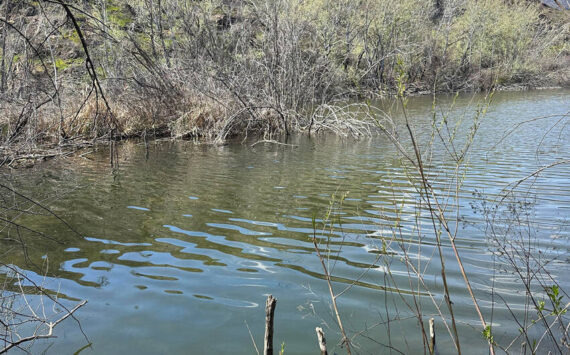2014 budget approved
TONASKET – Whether or not to give Tonasket voters the chance to decide to join or not join a mosquito district was the subject of much discussion at the Tuesday, Dec. 10, session of the Tonasket City Council.
Chris Branch, Oroville Director of Community Development and Gary Headlee, proponents of a proposed county-wide mosquito district, were on hand to share information about what such a district would involve.
In order for Tonasket’s participation in a mosquito district to become a reality, the council would need to approve a proposition to be included in the mosquito district, which will be decided in a county-wide ballot. The district could involve non-contiguous “pods” of mosquito eradication efforts centered on municipalities throughout the county.
“We want to make sure you have the opportunity to consider the issues related to the district,” Branch said. “In the Omak/Okanogan area where the concept started to develop – there is a citizen group there interested. Omak has had a spray program for years and some folks don’t appreciate the spray program It doesn’t always work very well… You spray them when they are lying around. They go away for a little while … sometimes when they were going to go away anyway.”
Headlee said the district would use tactics similar to those currently used in Curlew, where cubes of BTS ( a type of BTI) are used in marshy areas to kill larvae.
The district would be paid for through a property tax assessment.
Mayor Patrick Plumb said that most of the objections in Tonasket to mosquito treatment have been to the types of chemicals used.
“If we can go BTI, the community seems more open to that,” Plumb said. “I personally would like to be able to vote on it.”
Oroville’s council recently adopted a resolution to be included within the district that will be voted on county wide.
Tonasket’s council members were divided over the potential for enforcement issues involved with the district.
“They are charged with going around and looking for breeding areas that aren’t natural breeding areas – old tires, that kind of thing,” Branch said. “So they do have a bit of an enforcement function.”
“I would be thrilled with mosquito control enforcement,” said council member Claire Jeffko.
“Not me,” said council member Jean Ramsey. “I would worry about the enforcement side.”
“I think we should look at allowing our community to enter this as appropriate,” said council member Scott Olson. “Two concerns: I don’t think people who live outside of a place with a lot of mosquitoes should be paying for those that would much more benefit. Two, it’s more holistic than the city spraying it’s area and someplace 100 yards away gets the benefit at no cost.”
The council voted 3-2 (Jeffko, Olson and Dennis Brown in favor, Ramsey and Vugteveen opposing) to draft a resolution that will be considered at a future council meeting whether or not to allow the public to vote on joining the mosquito district.
Budget finalized
The council approved, by a 4-1, a $3.097 million budget for 2014. Council members Claire Jeffko (motion), Jill Vugteveen (second), Scott Olson and Dennis Brown approved the budget, while Jean Ramsey opposed.
The budget included a 1.5 percent Cost of Living Adjustment for city employees that had been discussed at length at the previous council session.
“The city council has worked well together as a team,” Plumb said in his statement following the budget approval, “not letting their policy disagreements at times divide their unity to making this city government be an example to other cities… the city benefits greatly by having such great leaders serving our city.”
Heavy haul corridor
“I have concerns about why (a Heavy Haul Corridor) is such a priority when… we can only afford to chip seal only the driving lanes through town.” Tonasket Mayor Patrick Plumb
City planner Kurt Danison, Highlands Associates, reported that turning US-97 from Oroville to Pateros into a Heavy Haul Corridor apparently “has some traction,” as he put it.
“I don’t know what to think because I’m not sure what the objective is,” Danison said. “But I would encourage the community to weigh in. There are several questions.
The highway runs through town – there are only two towns in the state that it runs right through downtown. The rest have bypasses.
“The other is the impact on the railroad…. It may run the railroad out of business. We need to have a discussion and let the communities weight in on that.”
Plumb expressed his frustration with the possibility on a couple of fronts. First, he said, the ongoing battle with getting US-97 (Whitcomb Ave.) repaired, rather than patched, happening on one hand made the possibility of straining the existing infrastructure untenable. On the other, he said, no one had contacted the city to discuss the implications of running that much freight through Tonasket’s downtown business core.
“I already made a call to the (Department of Transportaion),” Plumb said. “I’m not terribly pleased that no one talked to us at all. I told the DOT they needed to come up and talk to us. I had specific concerns about why this is such a priority when supposedly we can only afford to chip seal only the driving lanes through town.
“Now all of a sudden we can have trucks crossing bridges when we don’t know their conditions; infrastructures under 97 that I guarantee are failing, like stormwater (drainage). It sure didn’t do very good this summer. We are advocating for a real honest discussion.”
Danison said that the Heavy Haul plan could provide the impetus for getting the highway needs through town taken care of.
“I suggested to the city to see if we could make a capital budget request to rebuild Whitcomb – streets, sidewalks, curbs, gutters, underground utilities, conduits, lights, trees … all of it.,” he said. “We did put together a 2-3 page summary with photos and issues. We had Varela come up with an estimate… for about $5 million.
“We are asking them to look into adding it as a capital budget item. Our conversations are going on with our senators and representatives… this could give you more ammunition when you’re asking the legislature for $5 million.”
Other highlights of Danison’s report included:
- The city received a grant for about $92,000 from the Transportation Alternatives Program to put in a sidewalk that would extend from the corner of 6th and Whitcomb (US-97) to the Bonaparte Creek Bridge at the south end of town. This would provide additional infrastructure to support a proposed foot bridge that would allow pedestrians to cross the creek to the U.S. Armed Forces Legacy Park.
- Danison said he was asking the mayors of the various communities with airports to contact the county commissioners in an effort to finalize zoning maps to regulate construction round airports, particularly in the runway approach zones. Each community had customized maps for the areas surrounding their airports, but the project has been stalled for about a year.
- A community meeting to discuss and give the council guidance on the parameters (and ultimately, a go or no-go) on replacing the Tonasket swimming pool was tentatively set forthe Tonasket High School Commons on Jan. 7. However, due to a scheduling conflict, that date may need to be changed.
Whenever it takes place, Danison said, what happens there will be critical to the project’s future.
“Hopefully it becomes a community effort,” Danison said. “If not it comes back to what Scott Olson says. Even if we get all the money to build the pool, it could still cost $25,000-$40,000 to take care of it, which is money we don’t have. This year you would probably have had to close it (due to lack of funds). It has to have community support or it’s not going to happen.”
RV Park lease
Plumb announced that the city and Burlington Northern’s lease company agreed to, in perpetuity, allow the city to continue to lease the RV Park property from the railroad for $200, with a three percent annual increase. Originally the lease company had sought to increase the rate to $5,700 a year, which the city rejected.
“I think that’s phenomenal,” Olson said.
The City Council next meets on Tuesday, Jan. 14.




